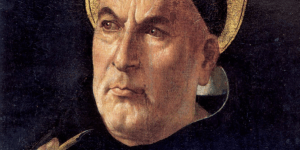By Fr. Thomas F. O’Meara, O.P.
The number and size of Catholic grade schools and high schools increased greatly in the 1950s. After 1960, the educational preparation of teachers, new issues for church life amid movements like ecumenism, racial justice in American society, and a general advancement in the quality of Catholic schools led to new considerations of the area of “religion,” of “theology,” in secondary education.

At Fenwick High School, conducted by the Dominican Friars in Oak Park, Illinois, a suburb of Chicago, two movements emerged to expand and vitalize theological education in high school. One had to do with educational materials like textbooks; the other had to do with new approaches to religious education, with ideas for and beyond the classroom.
New Theology and New Textbooks
The developments in secondary education began with similar movements in Catholic colleges and universities. The simple and sparse catechetical format of the texts for required courses in religion in Catholic colleges and universities was more and more criticized in the 1950s. The shallow level of content often did not rise above basic catechetical propositions about Christianity to which was added some Aristotelian philosophy in ethics and theodicy. Some have gone so far as to say that prior to 1960 there was no theology being taught in most Catholic institutions of higher education in America other than seminaries. Certainly few courses touched on, for instance, the content of the New Testament or the theology of the sacraments and liturgy.
In those years teachers began to meet to discuss how teaching theology in college was more than teaching scholastic philosophy or catechesis. In 1954, they founded the Society of Catholic College Teachers of Sacred Doctrine (this became in 1965 the College Theology Society).1 At the first national meeting of the SCCTSD in 1954 (there had been regional meetings) three of the founders offered their approaches. Gerard Sloyan of Catholic University of America spoke on “From Christ in the Gospels to Christ in the Church;” Thomas Donlan, O.P., of St. Rose Priory, Dubuque, Iowa, presented “An Approach from the Dominican School of Thought;” John Fernan, S.J., of Le Moyne College, Syracuse, New York, described a “historical, Scriptural approach.” These pioneers of the college theology movement had three different views of theological education: Sloyan’s was biblical; Donlan’s was neo-Thomist; Fernan’s was historical and biblical. All three were working on producing textbooks.

Theodore Hesburgh, C.S.C., in 1945 returned to the University of Notre Dame to begin his time of teaching theology there before he became president of that institution. He had written his doctoral dissertation at The Catholic University of America on the theology of lay people and the sacraments.2 Teaching undergraduate theology soon led to his conceiving of and editing textbooks, a series called “University Religion Series. Texts in Theology for the Layman.”3
Thomas Donlan, O.P., a native of Oak Park, Illinois, taught at Fenwick High School from 1946 to 1952. He went from there to teach at the Dominican seminaries in Dubuque, Iowa. While there he directed original publications in college and high school theological education. First he supervised a volume of essays exploring how sacred doctrine of a largely Thomist bent could and should be the framework for courses outside the seminary. Essays treated the arts, sociology, and the natural sciences, philosophy, and religion: This was an attempt to draw theology out of the isolation of clerical circles into a wider cultural world.4

from Oak Park.
Donlan and other Dominicans, some teaching at the first graduate program in theology to accept religious or laity at St. Mary’s College, South Bend, Indiana, decided to produce a series of textbooks for college. First books began to appear in 1952.5 They did offer a theology deeper than a catechism, but curiously it did not hold a particularly Thomistic order and principles and retained the order of apologetic manuals from 1860 to 1960. A second series of texts appearing in 1959 was a greatly improved enterprise. They held sections of Aquinas’ Summa theologiae, and included material from Scripture and practical moral theology.6
Continue reading “Religious Education and Fenwick High School: New Directions in the 1960s”

























 Brother John Steilberg joined Fenwick’s
Brother John Steilberg joined Fenwick’s 